Physical Address
304 North Cardinal St.
Dorchester Center, MA 02124
Epithelial neoplasms predominate in the gastrointestinal (GI) tract, as they do in all parenchymal organs and organ systems. However, a wide array of mesenchymal neoplasms also arises in the GI tract, some of which are exclusive or nearly exclusive to such sites. Other mesenchymal tumors that also arise in somatic soft tissue have distinctive features in the GI tract. Most mesenchymal neoplasms are uncommon or rare, and many have overlapping histologic features; therefore, they may be difficult to classify accurately. The purpose of this chapter is to discuss the clinical and pathologic features of the most common mesenchymal tumors of the tubal GI tract, as well as more recently recognized and rarer tumor types. This chapter also focuses on applications of immunohistochemistry and (when relevant) molecular genetics with an emphasis on differential diagnosis. Screening colonoscopy is widely used today, and distinctive colorectal polyps containing spindle cell proliferations are increasingly being recognized; these polyps are also covered in some detail to allow for proper diagnosis.
When confronted with a spindle cell neoplasm in the GI tract, it is necessary to ask two major questions. The first question is whether it is possible that the tumor is an epithelial neoplasm masquerading as a mesenchymal neoplasm ( Box 16.1 ). Just because a neoplasm is composed largely of spindle-shaped cells does not mean that it is not a carcinoma. Remember that carcinomas are many times more common than mesenchymal neoplasms in the GI tract. Immunohistochemical staining for keratins is helpful in this context, because the majority of mesenchymal neoplasms are negative for keratins, whereas even spindle cell (sarcomatoid) and pleomorphic carcinomas are almost always at least focally positive for keratins. When sarcomatoid carcinoma is suspected, at least two keratins should be used; AE1/AE3 and CAM5.2 are excellent screening keratins in this context, which should “unmask” most sarcomatoid carcinomas. Careful histologic examination is critical, and submission of additional tissue sections may also be useful, because there may be focal areas of epithelial dysplasia or a component of conventional adenocarcinoma or squamous cell carcinoma, recognition of which can confirm the diagnosis.
Could the lesion be an epithelial neoplasm masquerading as a mesenchymal neoplasm?
Is the lesion a gastrointestinal stromal tumor?
Where is the lesion located?
Does the lesion involve the serosa, wall, or mucosa?
Does the lesion predominantly contain epithelioid or spindle-shaped cells?
Is there a principal architectural arrangement of the cells?
What does the cytoplasm look like? Quality? Color?
Is the lesion mitotically active?
Are there atypical mitotic figures?
Are there any distinctive features?
The second question to ask is whether the tumor is a gastrointestinal stromal tumor (GIST). GISTs compose up to 90% of clinically significant mesenchymal neoplasms of the GI tract; thus, this tumor type should always be considered in the differential diagnosis of mural spindle cell (or epithelioid) neoplasms. Although GIST can have a variety of histologic patterns, immunohistochemistry for KIT (CD117) and DOG1 has made the diagnosis relatively straightforward in most cases.
It is also important to appreciate that the distribution and frequency of different mesenchymal neoplasms vary considerably within different anatomic regions of the GI tract. For instance, a spindle cell neoplasm of the esophageal wall is more likely to be a leiomyoma than a GIST, whereas this situation is reversed in the stomach and small intestine. The distribution of the most common mesenchymal neoplasms according to anatomic location is summarized in Box 16.2 . It is important to know whether the lesion involves the mucosa, the wall, the mesentery, or the serosa. Mesenchymal tumors often have a characteristic depth of involvement in the tubal gut. For example, GIST usually involves the wall of the GI tract, whereas desmoid fibromatosis typically arises in the mesentery with secondary invasion into the bowel wall.
Leiomyoma
Granular cell tumor
Gastrointestinal stromal tumor
Schwannoma
Inflammatory fibroid polyp
Glomus tumor
Plexiform fibromyxoma
Gastrointestinal stromal tumor
Desmoid fibromatosis (mesentery)
Inflammatory fibroid polyp
Clear cell sarcoma-like tumor
Leiomyoma of the muscularis mucosae
Mucosal perineurioma
Polypoid ganglioneuroma
Perivascular epithelioid cell tumor (PEComa)
Once the basic information previously discussed has been determined, histologic features should be considered ( Box 16.3 ). Is the lesion monomorphic or pleomorphic? Is it composed predominantly of epithelioid cells or spindle-shaped cells? Is there a predominant architectural pattern such as nested for epithelioid neoplasms or fascicular for spindle cell neoplasms? What do the nuclei look like? What about the cytoplasm? How about the stroma—is it myxoid? Is the lesion mitotically active? Are there atypical mitotic figures? Are there any other distinctive features such as vacuolated cytoplasm or nuclear palisading? The discussions of the neoplasms in this chapter will examine each of these questions, with emphasis on approaches to differential diagnosis. Once a differential diagnosis has been generated based on site, depth, and histologic pattern, a specific diagnosis can be confirmed with a carefully chosen panel of immunohistochemical markers, in some cases supplemented with molecular studies.
GIST
Schwannoma
Leiomyoma
Leiomyosarcoma
Desmoid fibromatosis
Inflammatory fibroid polyp
Plexiform fibromyxoma
Clear cell sarcoma-like tumor
GIST (especially PDGFRA -mutant and succinate dehydrogenase-deficient gastric GIST)
Granular cell tumor
Glomus tumor
Clear cell sarcoma-like tumor
PEComa
GIST (especially PDGFRA -mutant epithelioid GIST)
Plexiform fibromyxoma
Leiomyosarcoma
Dedifferentiated liposarcoma
GIST , Gastrointestinal stromal tumor; PDGFRA , platelet-derived growth factor receptor A; PEComa , perivascular epithelioid cell tumor.
This chapter does not attempt to be absolutely comprehensive. Submucosal lipomas are relatively common in the colon, but diagnosis is usually straightforward, and these lesions are therefore not discussed. Well-differentiated and dedifferentiated liposarcomas may involve the wall of the GI tract; these tumor types are discussed in detail in Chapter 12 and will not be covered in this chapter, except in differential diagnosis when appropriate. Vascular lesions (other than vascular malformations) are rare in the GI tract and are histologically similar to their counterparts arising at other anatomic sites; these lesions are discussed in detail in Chapter 13 .
GISTs are the most common clinically significant mesenchymal neoplasm of the GI tract. Historically, these lesions were classified as smooth muscle tumors under the names leiomyoma, leiomyosarcoma, or leiomyoblastoma (the latter for epithelioid examples). However, it is now recognized that these tumors are not true smooth muscle neoplasms and must be distinguished from leiomyoma and leiomyosarcoma. Perhaps the most important message of this section is to exclude the diagnosis of GIST, especially in the stomach and small intestine, before considering other less common diagnoses.
GIST has gained considerable clinical importance; it has become the “poster child” for targeted therapy in solid tumors (see the section “ Prognosis and Treatment ”). GIST therapies target KIT and platelet-derived growth factor receptor A (PDGFRA), which are constitutively activated by mutation and drive cellular proliferation in most GISTs. Because effective systemic therapies for GIST are available, proper diagnosis is critically important. The finding of KIT activation in GIST also led to the realization that GISTs arise from interstitial cells of Cajal or precursors to such cells. Interstitial cells of Cajal are distinctive mesenchymal cells within the stomach and bowel wall that are involved in peristalsis. GIST is one of the few mesenchymal neoplasms for which the normal cellular counterpart has been identified.
GIST can develop at any age but is most common in middle-aged to elderly adults; the median age is 58 years. It occurs approximately equally in males and females. GIST can be seen at any site along the GI tract, including unusual sites such as the gallbladder, pancreas, and appendix, but is most common in the stomach (60%) and small intestine (30%). Rarely, GISTs appear to arise from extragastrointestinal soft tissues within the abdomen (mesentery or omentum), pelvis, or retroperitoneum; collectively, such tumors are known as extragastrointestinal GISTs. However, careful analysis of such lesions indicates that a major subset originates from the GI musculature, grow in an exophytic manner, and subsequently lose their attachment to the GI tract. True extragastrointestinal GISTs are exceedingly rare.
GIST has a tendency to ulcerate the mucosa; it typically presents with GI bleeding, anemia, or intestinal obstruction. Affected patients may present with a palpable mass. Massive intraabdominal hemorrhage is uncommon. Some tumors are identified incidentally by radiography, whereas other cases are found incidentally during endoscopy or surgery for unrelated reasons. Small, clinically insignificant tumors known as microGISTs are very common in the stomach, and are present in up to 35% of middle-aged to elderly adults.
Aggressive GISTs have a propensity for dissemination throughout the surfaces of the abdominal cavity and metastasis to the liver. Although GISTs are capable of metastasizing outside of the abdomen, primarily to lung and bone, this is a rare occurrence. Importantly, in contrast to carcinomas, GISTs rarely metastasize to lymph nodes (with notable exceptions; see subsequent discussion), making compulsory lymph node dissection unnecessary.
Rarely, GISTs occur in children (1%–2%), mainly in girls. Such tumors arise in the stomach, often as multifocal lesions, and commonly metastasize to lymph nodes. Gastric GISTs are also a major feature of two tumor syndromes: Carney triad (along with pulmonary chondroma and paraganglioma) and Carney-Stratakis syndrome (along with paraganglioma). Pediatric GISTs, the GISTs in patients with Carney triad and Carney-Stratakis syndrome, and up to 10% of gastric GISTs in adults outside of these syndromes have distinctive histologic features, clinical behavior, and molecular pathogenesis, and are now referred to collectively as succinate dehydrogenase (SDH)-deficient GISTs. GISTs are also a less common tumor type of type 1 neurofibromatosis (NF1); when present, such tumors typically arise as multiple lesions in the small intestine.
GISTs range from incidental minute lesions no more than 1 mm in size to large masses more than 40 cm in greatest dimension. The median size for clinically significant GISTs is 6 cm in the stomach, 4.5 cm in the duodenum, and 7 cm in the jejunum/ileum. Lesions are usually centered in the bowel wall with frequent mucosal ulceration ( Fig. 16.1 ). On cut section, they may be either fibrous or fleshy with central degeneration (see Fig. 16.1 ). Some GISTs are almost entirely cystic, whereas others are gelatinous or extensively necrotic.
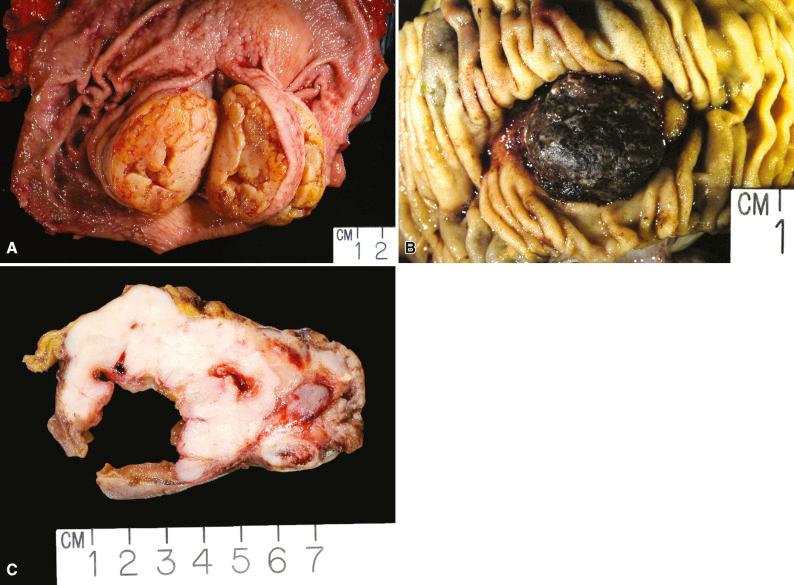
GISTs range from pure spindle cell neoplasms ( Fig. 16.2 ) to pure epithelioid neoplasms ( Fig. 16.3 ). A subset of tumors contains both spindle cells and epithelioid cells. Lesions vary considerably in terms of cellularity. Less-cellular neoplasms are generally smaller, tend to have hyalinized stroma, and may exhibit dystrophic calcifications ( Fig. 16.4 ). Spindle cell GISTs contain elongated nuclei with vesicular chromatin, inconspicuous nucleoli, and moderate amounts of fibrillary palely eosinophilic cytoplasm ( Fig. 16.5 ). The spindle cells are usually arranged in short fascicles. Nuclear palisading and paranuclear vacuolization are not unusual ( Fig. 16.6 ); the latter is a feature of gastric tumors. The vasculature may be minimal or prominent, hyalinized, or hemangiopericytoma-like, but there are no characteristic vascular features. A sparse chronic inflammatory component may be observed, most often scattered lymphocytes. So-called skeinoid fibers, variably sized collections of collagen fibrils, can also be found in the stroma of GISTs; this is seen almost exclusively in the small bowel ( Fig. 16.7 ). Epithelioid GISTs contain round nuclei, vesicular chromatin, variably prominent nucleoli, and abundant eosinophilic cytoplasm with ill-defined cell borders or clear cytoplasm with distinct cell borders ( Fig. 16.8 ). Binucleation is not unusual. The epithelioid cells are arranged in sheets or nests. When tumor cells are arranged in nests, this may impart a paraganglioma-like appearance. Myxoid stroma is more common in epithelioid GISTs ( Fig. 16.9 ).
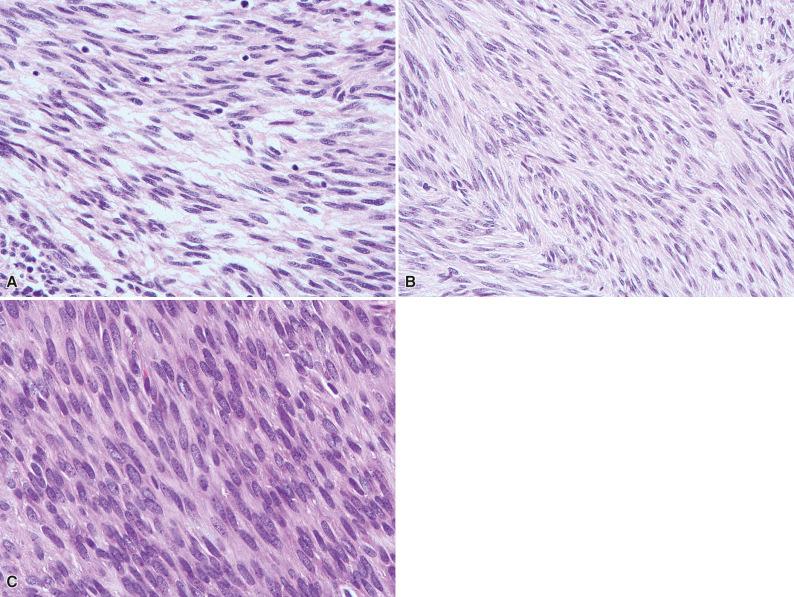
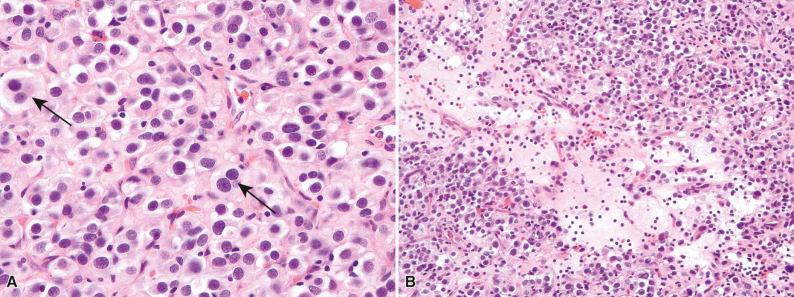
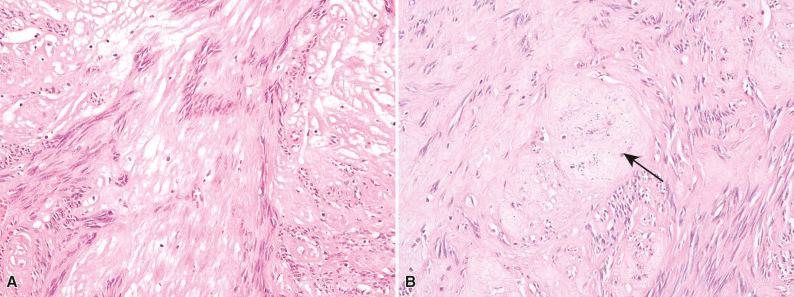
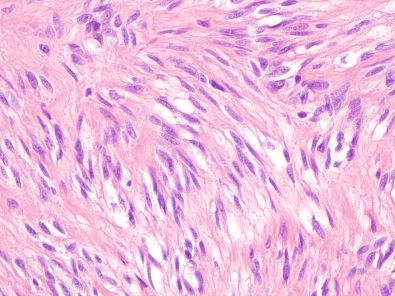
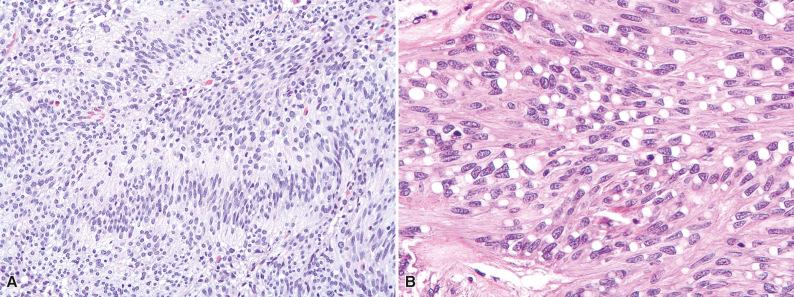
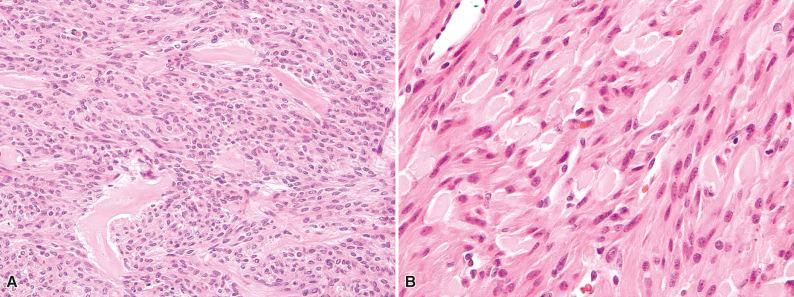
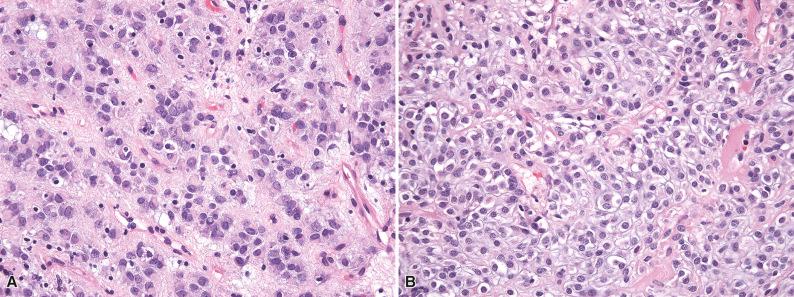
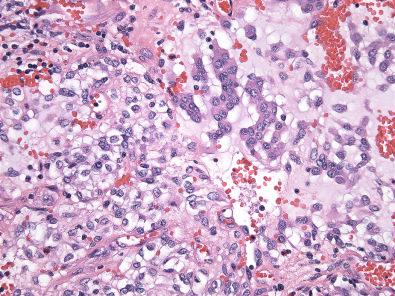
A distinctive multinodular or plexiform architecture is observed in SDH-deficient GISTs ( Fig. 16.10 ). This histologic pattern is characterized by coarse lobules of tumor separated by bands of normal smooth muscle or small nodules with irregular margins extending from the main tumor ( Fig. 16.11A ). Such a growth pattern should raise the possibility of this unusual subset of GISTs, because they show distinct clinical behavior. These tumors nearly always have epithelioid or mixed epithelioid and spindle cell morphology (see Fig. 16.11B ).
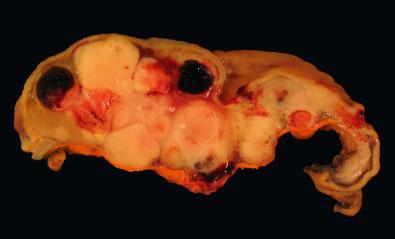
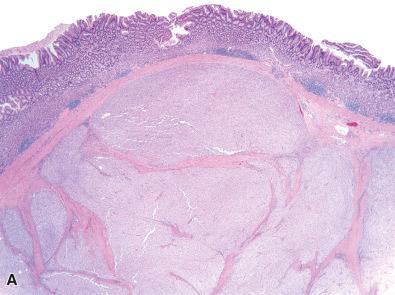
Mitotic activity is usually low in both epithelioid and spindle cell GISTs; the mitotic rate must be determined in 5 mm 2 to perform risk stratification (see the section “ Prognosis and Treatment ”). Furthermore, atypical mitotic figures are very rare. Nuclear pleomorphism is also highly unusual in GIST, observed in no more than 2% of tumors. More often than not, cytologic pleomorphism suggests the diagnosis of other sarcomas such as leiomyosarcoma. One notable exception is the very rare dedifferentiated GIST. Analogous to dedifferentiated liposarcoma, dedifferentiated GIST is defined by a transition from morphologically and immunohistochemically typical GIST to an anaplastic sarcomatous appearance that lacks the histologic features of GIST, as well as KIT and DOG1 expression ( Fig. 16.12 ). The dedifferentiated component may show a wide range of histologic appearances, ranging from a fascicular spindle cell appearance to wildly pleomorphic or resembling “inflammatory malignant fibrous histiocytoma.”
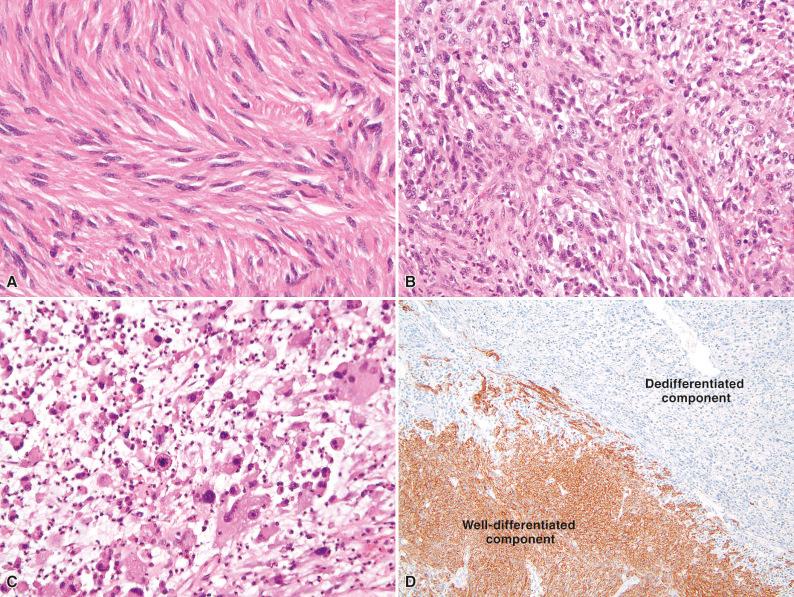
Approximately 95% of GISTs are strongly positive for KIT (CD117). KIT immunoreactivity is usually diffuse and cytoplasmic but may occasionally show a membranous or a dot-like (Golgi) pattern ( Fig. 16.13 ). The membranous pattern is the least common. Interestingly, KIT-negative GISTs tend to have epithelioid morphology, arise in the stomach, and harbor PDGFRA mutations. All other GIST genotypes usually express KIT diffusely and strongly. Approximately 70% of GISTs are positive for CD34, 30% for smooth muscle actin (SMA), and 5% for S-100. Desmin or keratin expression is observed in 2% and less than 1% of tumors, respectively. However, up to 20% of duodenal GISTs can be immunoreactive for S-100, usually focally, and 10%–15% of gastric epithelioid GISTs are focally positive for desmin. The smooth muscle marker h-caldesmon is positive in about 80% of GISTs; this marker therefore cannot be used to distinguish between GISTs and smooth muscle tumors. DOG1 (also known as ANO1, anoctamin 1) has been developed as an additional immunohistochemical marker. DOG1 is sensitive and relatively specific for GIST, and is diffusely and strongly positive in 98% of GISTs (see Fig. 16.13D ). It is especially useful in the diagnosis of KIT-negative GISTs and GISTs with only limited KIT expression ( Fig. 16.14 ).
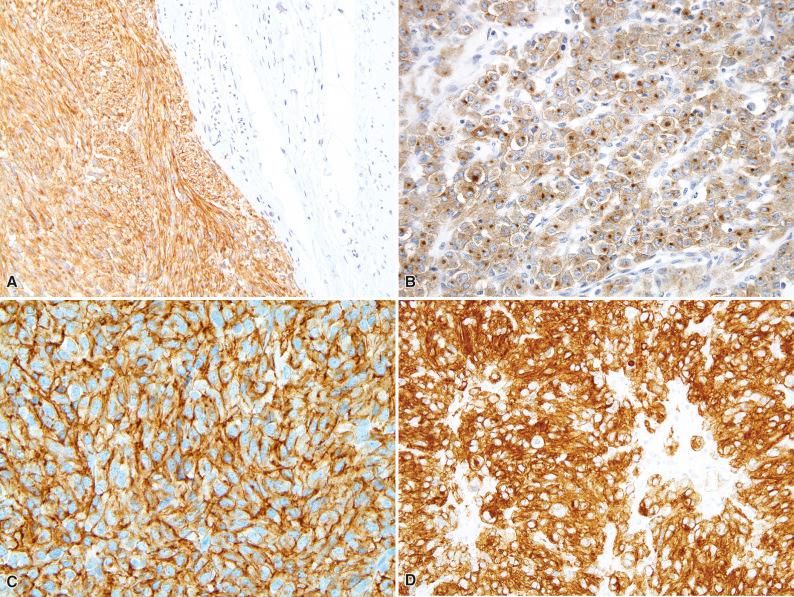
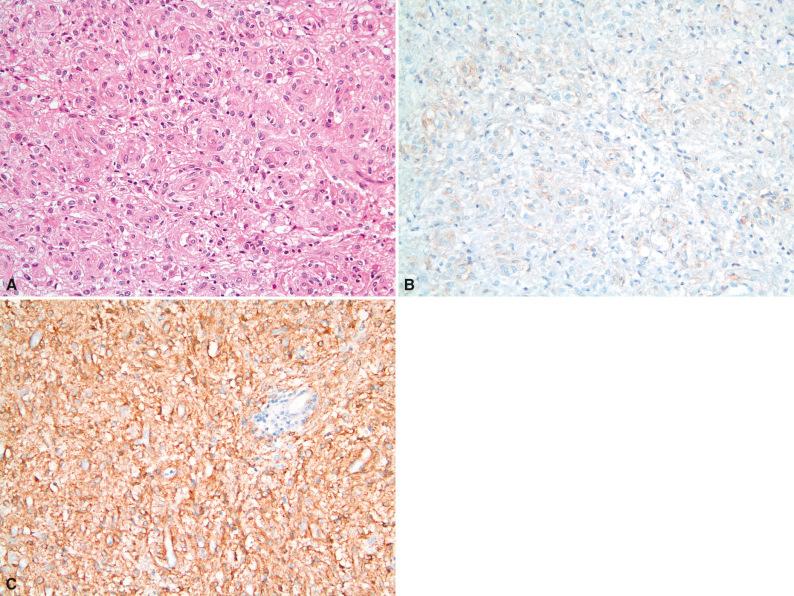
One warning regarding KIT staining: it is important to maintain good controls. Overzealous antigen retrieval or inadequate dilution may occasionally result in false positive staining. Mast cells, which are nearly always present in sections of bowel wall, show strong membranous staining for KIT and thus serve as an excellent internal control ( Fig. 16.15 ). The muscle wall should be entirely negative. When antigen retrieval is used, gastric glands may show weak nonspecific cytoplasmic staining for KIT. No such staining is seen without antigen retrieval.
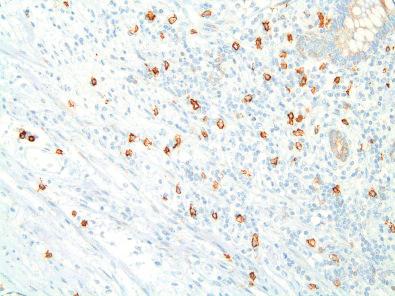
Immunohistochemistry for the mitochondrial protein succinate dehydrogenase subunit B (SDHB) can be used to identify SDH-deficient GISTs. These distinctive gastric GISTs show loss of SDHB expression (irrespective of the underlying mutation), whereas conventional adult GISTs show normal granular cytoplasmic (mitochondrial) staining ( Fig. 16.16 ). SDH-deficient GISTs with SDHA mutations (see below) show loss of SDHA expression as well as SDHB; SDHA can therefore be used to identify SDHA -mutant tumors.

About 80% of advanced GISTs contain activating KIT mutations. There are four mutation “hotspots,” which makes identification of mutations relatively straightforward ( Fig. 16.17 ). In about 65% of GISTs, KIT mutations are identified in exon 11, 10% in exon 9, and approximately 1% each in exons 13 and 17. Activating mutations in PDGFRA are identified in 5%–10% of advanced GISTs (see Fig. 16.17 ). The most common “hotspot” in PDGFRA is exon 18 (nearly always the D842V substitution), followed by exons 12 and 14. PDGFRA mutations are found predominantly in gastric and omental GISTs with epithelioid cytomorphology. KIT or PDGFRA mutations are found in the smallest, subcentimeter microGISTs and thus are thought to constitute the earliest molecular events in most GISTs. KIT and PDGFRA mutations are mutually exclusive. All of the mutant forms of KIT and PDGFRA encode virtually full-length, constitutively activated KIT and PDGFRA, which drive cellular proliferation. Inhibition of KIT or PDGFRA has a dramatic therapeutic effect in GIST. Those GISTs without identifiable KIT or PDGFRA mutations are known as wild-type GISTs. This group is comprised predominantly of SDH-deficient GISTs (5% of all GISTs), BRAF V600E-mutant GISTs (1% of all GISTs; Fig. 16.18 ), and NF1 -mutant GISTs (1% of all GISTs). Very recently, extremely rare gene fusions involving FGFR1 and NTRK3 have been identified in GISTs. Finally, there is still a group of exceedingly rare, truly wild-type GISTs known as quadruple-wild-type GISTs that do not have any apparent oncogenic driver mutations. The genetics of GISTs is also discussed in Chapter 18 .
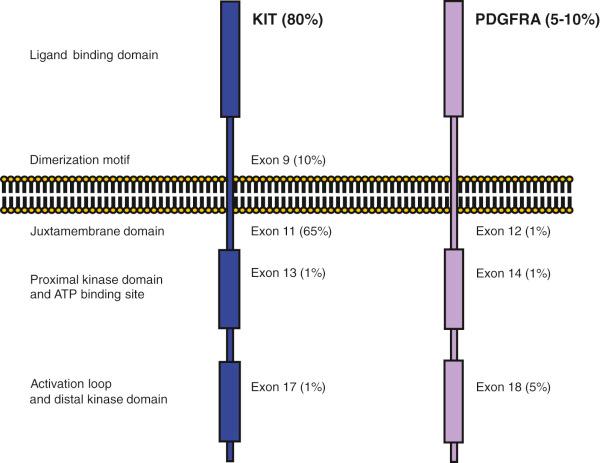
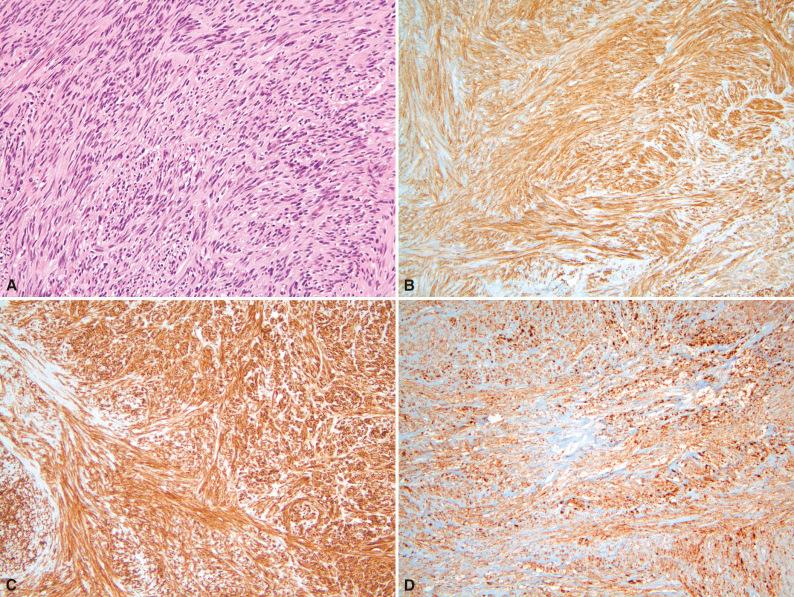
Multiple families have been identified with familial GIST. Affected patients harbor germline mutations in KIT or PDGFRA of exactly the same types that are found in sporadic GISTs. Patients who harbor germline KIT or PDGFRA mutations develop GIST with nearly 100% penetrance. As mentioned earlier, GIST is also associated with several tumor syndromes. Approximately 7% of patients with NF1 develop GISTs. NF1-associated GISTs typically arise in the small intestine as multiple small tumors. GIST is also associated with Carney-Stratakis syndrome, which is characterized by paraganglioma and gastric GIST. Similar to familial paraganglioma, patients with Carney-Stratakis harbor germline mutations in the SDH subunit genes SDHB, SDHC, or SDHD. Sporadic (non-syndromic) SDH-deficient GISTs also harbor germline or less commonly somatic mutations in SDHA, SDHB, SDHC, or SDHD . Overall, SDHA mutations are the most common alterations in this group of tumors, found in 35%–40% of SDH-deficient GISTs. As mentioned previously, pediatric GISTs, similar gastric GISTs in adults, and GISTs in patients with Carney triad and Carney-Stratakis syndrome show loss of SDHB protein expression by immunohistochemistry and SDH function, irrespective of whether they have germline mutations in SDH subunit genes (or which particular gene is mutated). Patients with Carney triad develop epithelioid gastric GIST, pulmonary chondroma, and extraadrenal paraganglioma. The genetic basis of Carney triad has recently been elucidated; in most cases, this syndrome is due to hypermethylation of the SDHC promoter, which also leads to loss of SDHB expression. Mutational analysis for KIT and PDGFRA is recommended if imatinib therapy is initiated for unresectable or metastatic disease (see later discussion). Mutational analysis should also be performed for patients with primary localized disease, when tumors are intermediate or high risk; adjuvant imatinib therapy prevents recurrence in such patients. This analysis is straightforward and does not require frozen tissue; the genomic “hotspots” can be amplified from DNA derived from paraffin-embedded tissue.
It is taken for granted that KIT or PDGFRA mutation is the initiating event in the pathogenesis of most GISTs. However, not as much is known about the secondary events involved in malignant progression. The accumulated data from cytogenetic and comparative genomic hybridization analysis indicate that losses at chromosomes 14q and 22q are very frequent and are not believed to contribute to malignant behavior. However, losses at 1p, 9p/9q, 11p, and 15q, as well as gains at 5p, 8q, 17q, and 20q, are reported more often in clinically aggressive GISTs. In general, greater numbers of genetic changes correlate with more aggressive behavior.
Loss of 9p is associated with an aggressive clinical course and appears to represent loss of the CDKN2A locus. The CDKN2A locus encodes two distinct tumor suppressor genes, p16 ( INK4A ) and p14 ( ARF ). Loss of both transcripts contributes to the aggressive phenotype.
The differential diagnosis for GIST is broad, but it is important to remember that GISTs are the most common mesenchymal neoplasms of the GI tract. Therefore when confronted with a mesenchymal neoplasm that involves the tubal gut, especially the stomach and small intestine, the diagnosis is very likely to be GIST. However, other tumor types can mimic GIST: leiomyoma, leiomyosarcoma, schwannoma, and desmoid fibromatosis, among others. Fortunately, immunohistochemistry is very helpful in resolving this differential diagnosis ( Table 16.1 ). Mural leiomyomas are most common in the esophagus, whereas polypoid leiomyomas of the muscularis mucosae arise in the colorectum; at both of these sites, leiomyoma is more common than GIST. In contrast to GIST, leiomyoma is composed of fascicles of spindle cells with blunt-ended (cigar-shaped) nuclei, brightly eosinophilic cytoplasm, and well-defined cell borders. Leiomyoma is invariably diffusely and strongly positive for SMA and desmin, and negative for KIT and DOG1. Of note, esophageal leiomyomas often contain numerous KIT-positive mast cells and interstitial cells of Cajal, which can be a diagnostic pitfall if mistakenly interpreted as positive staining in tumor cells. Primary leiomyosarcomas of the GI tract are very rare, vastly outnumbered by GISTs. In contrast to GIST, leiomyosarcomas usually have prominent cytologic pleomorphism and a high mitotic rate, including atypical mitotic figures. Leiomyosarcoma is usually positive for SMA, very often positive for desmin, and negative for KIT. In the GI tract, schwannomas are most common in the stomach, and in this location, they tend to have prominent peripheral lymphoid aggregates. Gastric schwannomas generally lack the varying cellularity (Antoni A and B zonation), Verocay bodies, and hyalinized vessels typical of schwannomas of peripheral nerves. GI schwannomas have a greater degree of cytologic variability than GIST and often contain prominent stromal collagen. Schwannomas are invariably positive for S-100 and negative for KIT. Desmoid fibromatosis usually involves the mesentery with secondary invasion into the bowel wall. Desmoid tumors are composed of long fascicles of spindle cells often with prominent stromal collagen. These tumors are focally positive for SMA but are negative for KIT and DOG1. About 80% of desmoid tumors show aberrant nuclear staining for β-catenin, which can be used to confirm the diagnosis.
| Diagnosis | KIT and DOG1 | Desmin | S-100 |
|---|---|---|---|
| GIST | +++ (95%–98%) | — (2%) | — (5%) |
| Leiomyoma | — | +++ (100%) | — |
| Leiomyosarcoma | — | ++ (50%) | — |
| Schwannoma | — | — | +++ (100%) |
| Desmoid fibromatosis | — | — | — |
Epithelioid GIST should be distinguished from well-differentiated neuroendocrine (carcinoid) tumor, poorly differentiated adenocarcinoma, and glomus tumor. Carcinoid tumors often have a predominantly trabecular or nested architecture, and the uniform tumor cells contain scant cytoplasm and finely granular (“salt and pepper”) chromatin. Keratin and chromogranin are strongly positive, whereas KIT and DOG1 are negative. Poorly differentiated adenocarcinomas of the stomach frequently have signet-ring–cell morphology with eccentric nuclei and a single mucin-containing cytoplasmic vacuole, and they are positive for broad-spectrum keratins, often for CK20 and CDX-2, and usually negative for KIT and DOG1 of note, a subset of gastric adenocarcinomas is positive for DOG1, which is a potential diagnostic pitfall. Glomus tumors rarely develop in the GI tract, most often in the wall of the stomach. Like a subset of epithelioid gastric GISTs, glomus tumors are composed of sheets of uniform rounded to epithelioid cells with sharply demarcated cytoplasmic borders. A helpful diagnostic clue is subendothelial growth within blood vessel walls, often most easily appreciated at the periphery of the tumor. Glomus tumors are strongly positive for SMA and caldesmon but negative for KIT and DOG1.
GISTs range from those with essentially no risk of metastasis to those with a high risk of aggressive behavior. The system of risk stratification most commonly used is based on anatomic site, tumor size, and mitotic activity ( Table 16.2 ). Importantly, this risk stratification system does not apply to SDH-deficient GISTs; tumor size and mitotic rate do not predict progression in these tumors. There are three Food and Drug Administration–approved targeted therapies for GIST. Imatinib mesylate, sunitinib malate, and regorafenib are small molecule inhibitors that directly target KIT and PDGFRA. Imatinib is used as first-line therapy primarily in the setting of metastatic or unresectable GIST, and sunitinib is used in patients who do not tolerate imatinib or have progressed on imatinib therapy. Regorafenib is used primarily in patients who fail both imatinib and sunitinib. Interestingly, although patients with most tumors respond well to imatinib, some genetic subsets do not respond as well or at all. As is expected, GISTs associated with NF1, SDH-deficient GISTs, and BRAF -mutant GISTs do not respond to KIT/PDGFRA inhibitors. KIT exon 9 mutant tumors tend to respond less well; increasing the daily dose of imatinib from 400 to 800 mg can overcome the lack of response in KIT exon 9 mutant tumors. GIST patients with the most common PDGFRA mutation, D842V, do not respond to any of the FDA-approved GIST therapies and should be enrolled in clinical trials with experimental agents. Secondary resistance to imatinib, defined as those GISTs that initially respond to imatinib but after a period of 6 months or more show tumor progression on therapy, is seen within 2 years in about 50% of patients with GIST. Secondary resistance is usually due to second-site intraallelic mutations in KIT , which abrogate binding to imatinib. Patients who develop secondary resistance to imatinib can benefit from treatment with sunitinib and regorafenib. Interestingly, although only few cases have been reported, GISTs with BRAF V600E mutations appear to respond to BRAF inhibitors.
| Mitotic Index (per 5 mm 2 ) a | Size (cm) | Risk of Progressive Disease a | |||
|---|---|---|---|---|---|
| Stomach | Duodenum | Jejunum/Ileum | Rectum | ||
| ≤5 | ≤2 | None (0%) | None (0%) | None (0%) | None (0%) |
| ≤5 | >2–5 | Very low (1.9%) | Low (8.3%) | Low (4.3%) | Low (8.5%) |
| ≤5 | >5–10 | Low (3.6%) | Insufficient data | Moderate (24%) | Insufficient data |
| ≤5 | >10 | Moderate (10%) | High (34%) | High (52%) | High (57%) |
| >5 | ≤2 | None; small number of cases | Insufficient data | High; small number of cases | High (54%) |
| >5 | >2–5 | Moderate (16%) | High (50%) | High (73%) | High (52%) |
| >5 | >5–10 | High (55%) | Insufficient data | High (85%) | Insufficient data |
| >5 | >10 | High (86%) | High (86%) | High (90%) | High (71%) |
a Defined as metastasis or tumor-related death. Field diameter should be determined for individual microscopes. On most modern microscopes, 5 mm 2 is equivalent to approximately 20 high-power (40×) fields. Data are based on long-term follow-up of 1055 gastric, 629 small intestinal, 144 duodenal, and 111 rectal GISTs.
Occasionally, GISTs are resected after treatment with targeted therapies. Although changes such as hypocellularity, hyalinosis, myxoid stroma, and necrosis have been described, these changes do not appear to correlate reliably with clinical response. It is reasonable to note the histologic appearance of treated GISTs in pathology reports; however, evaluating treatment response histologically does not play a role in the current management of patients with GIST. Occasionally, treated GISTs may show morphologic changes, such as a shift from spindle cell to epithelioid morphology or the development of pleomorphism, and rare GISTs lose KIT expression or otherwise change their immunophenotype, such as acquiring expression of smooth muscle markers. A very rare form of tumor progression in GISTs following tyrosine kinase inhibitor therapy is the development of heterologous rhabdomyosarcomatous differentiation, indistinguishable from embryonal or pleomorphic rhabdomyosarcoma. This unusual form of clonal evolution is associated with extremely aggressive clinical behavior.
GISTs rarely recur at anastomotic sites, and relatively narrow surgical margins are therefore adequate to achieve local control (e.g., wedge resection or partial gastrectomy for gastric tumors). The one notable exception is SDH-deficient GISTs, which often recur locally in the stomach, sometimes years or even decades following primary excision.
Leiomyoma is the second most common mesenchymal tumor of the GI tract, after GIST. It is difficult to obtain accurate numbers as to what proportion of mesenchymal tumors are leiomyomas due to referral bias in most large series, but a single institution series estimated that they composed 32% of all mesenchymal neoplasms of the GI tract. GIST accounted for 54% of these tumors, so both tumor types combined represented 86% of all mesenchymal neoplasms of the GI tract.
Leiomyomas are most common in the colorectal region. Approximately 80% of leiomyomas occur in this area, where they almost always present as small submucosal polyps that arise from the muscularis mucosae ( Fig. 16.19 ). The second most common site for leiomyoma is the esophagus. Approximately 10% of leiomyomas are found in this location. Esophageal leiomyomas usually arise from the muscularis propria, where they form intramural masses, but may rarely occur as polyps. Intramural leiomyomas tend to form much larger masses than polypoid leiomyomas. Leiomyomas of the stomach and small intestine are rare and predominantly intramural.
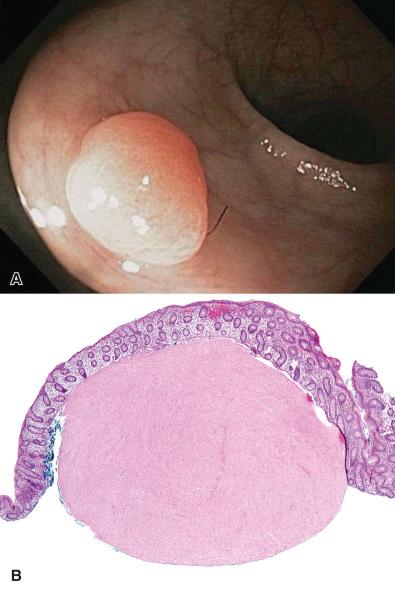
Leiomyomas are more common in men, with a 2.4 : 1 male-to-female ratio in the colorectal region and a 2 : 1 ratio in the esophagus. Leiomyomas can occur over a wide age range. In the colon, they are more common in middle-aged to elderly adults with a median age of 62 years, whereas in the esophagus they occur in a younger population with a median age of 35 years.
Presenting symptoms depend on location. In the esophagus, patients present with dysphagia, cough, or GI bleeding, or tumors can present as incidental masses. On occasion, they can mimic mediastinal masses. In the colorectal region, leiomyomas are most often identified incidentally during screening colonoscopy.
Leiomyomas present in the colorectal region as small polyps, ranging in size from 1 to 22 mm (median, 4 mm; see Fig. 16.19 ). Mural leiomyomas of the esophagus are larger, ranging in size from 1 to 18 cm (median, 5 cm; Fig. 16.20 ). Leiomyomas are well circumscribed but unencapsulated and are often lobulated, with a firm consistency. On cut section, the tumors are white to tan with a whorled, fibrous appearance.
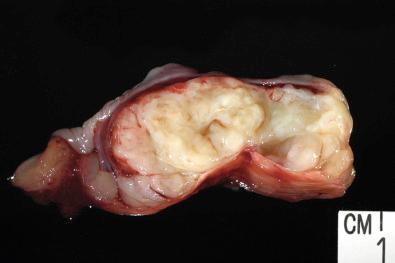
Histologically, leiomyomas are composed of fascicles of spindle cells with brightly eosinophilic cytoplasm and elongated, broad (cigar-shaped) nuclei with tapering or blunt ends ( Fig. 16.21 ). Cytologic atypia is rare, but degenerative nuclear atypia has been described in several cases that contained bizarre cells similar to symplastic leiomyoma of the uterus. Mitotic activity is very low or absent, usually less than 1 per 50 high-power fields. Necrosis is not seen. Epithelioid leiomyomas of the GI tract have not been described.
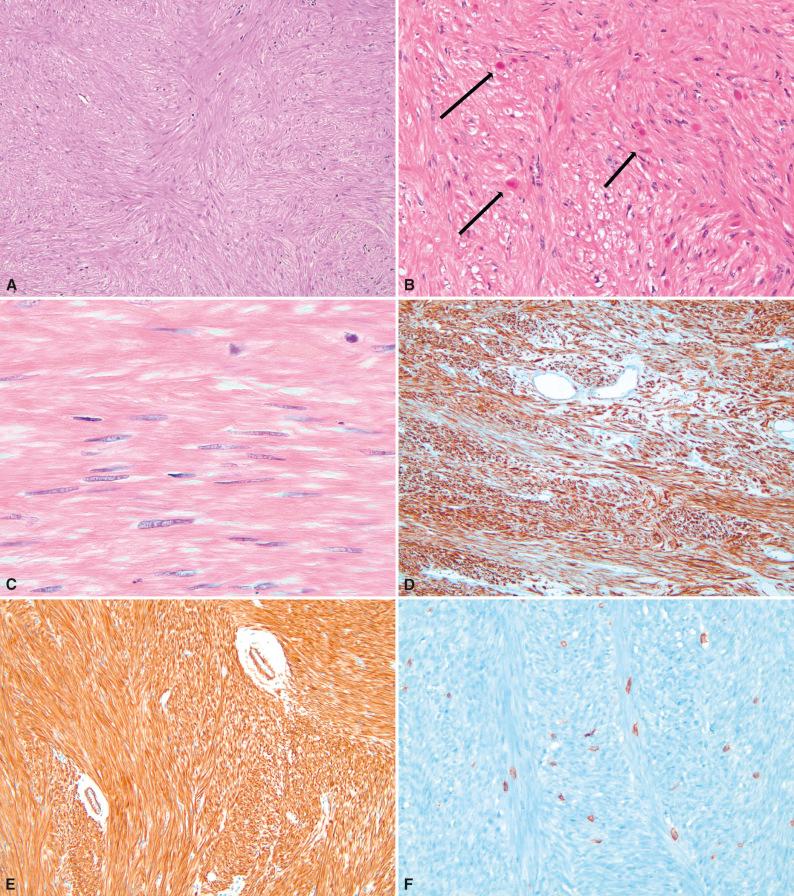
As is seen in GIST, if a concerted effort is made to detect clinically inapparent leiomyomas, they are actually quite common. In one study, 150 esophagogastric resection specimens that were removed for carcinomas were examined in detail with an average of 30 sections per case. Small (mean, 1.7 mm) esophageal leiomyomas were identified in 47% of patients. Interestingly, many patients had multiple lesions with a mean of three leiomyomas (one patient had 13 individual lesions).
All leiomyomas are uniformly positive for SMA, desmin, and caldesmon (see Fig. 16.21D and E ). They are negative for CD34, KIT, DOG1, and S-100. Esophageal mural leiomyomas often contain numerous KIT-positive mast cells (see Fig. 16.21F ), as well as KIT- and DOG1-positive interstitial cells of Cajal.
Very limited data are available regarding the molecular features of GI leiomyomas. Deletion of COL4A5 and COL4A6 at Xq22, encoding collagen type IV alpha 5 and alpha 6, has been reported in a single case of esophageal leiomyoma. This gene region is also lost in diffuse esophageal leiomyomatosis, which is characterized by replacement of the esophageal muscularis propria by an abnormal nodular smooth muscle proliferation. Diffuse leiomyomatosis predominantly affects children and adolescents but can occur at any age. Leiomyomatosis can occur sporadically or as a familial syndrome, usually associated with Alport syndrome, which is characterized by an inherited nephropathy. One case of a large discrete leiomyoma has been described in the setting of familial diffuse leiomyomatosis.
The differential diagnosis of leiomyoma primarily includes GIST and to some extent schwannoma. It is important to remember that clinically apparent leiomyomas occur in an inverse anatomic distribution compared with GIST. Leiomyomas are more common than GIST in the esophagus and colorectal region, whereas GISTs are vastly more common in the stomach and small intestine. Schwannomas are rare in the GI tract and occur most often in the stomach. Leiomyomas are generally less cellular and more brightly eosinophilic than GIST, lack mitotic activity, and in contrast to GIST, are diffusely and strongly positive for desmin and negative for KIT and DOG1. In contrast to leiomyomas, schwannomas are negative for desmin and diffusely and strongly positive for S-100. As previously mentioned, numerous KIT-positive mast cells can be seen in leiomyomas (as well as schwannomas), which is a potential diagnostic pitfall.
Leiomyomas are universally benign. Colorectal polypoid leiomyomas are treated by polypectomy alone, whereas intramural leiomyomas can be excised by myomectomy or segmental resection.
True leiomyosarcomas of the GI tract are extremely rare. It is difficult to estimate the precise incidence of such tumors, but in a large study of 262 mesenchymal tumors of the GI tract, there were only three bona fide leiomyosarcomas, amounting to scarcely more than 1% of the total.
Leiomyosarcomas can occur at any site within the GI tract but are most common in the small intestine and colon. Patients may present with anemia, GI bleeding, dysphagia, or bowel obstruction, depending on the anatomic location. For instance, individuals with esophageal leiomyosarcomas are more likely to present with dysphagia, whereas those with leiomyosarcomas of the small intestine are more likely to present with obstruction. Leiomyosarcomas can develop over a broad age range but tend to predominate in middle-aged to elderly adults, and the tumors are slightly more common in men.
Grossly, GI leiomyosarcomas are usually large ( Fig. 16.22 ). In one report of leiomyosarcomas of the duodenum, the five lesions ranged from 10 to 19 cm (median, 13 cm). The tumors generally involve the full-thickness of the bowel wall, including the mucosa, which is often ulcerated, as well as the serosal surface. Leiomyosarcomas can also occur as ulcerated intraluminal polypoid masses. These tumors may be lobulated, and on cut section they are gray, pink, or tan fleshy masses, often with areas of necrosis.
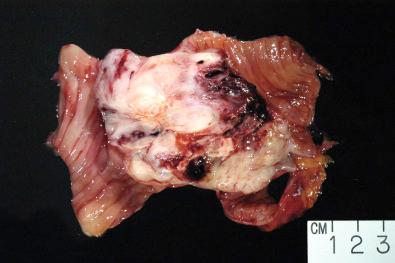
Histologically, GI leiomyosarcomas are similar to leiomyosarcomas elsewhere. They are composed of fascicles of spindle cells with elongated nuclei with blunt or tapering ends and brightly eosinophilic cytoplasm ( Fig. 16.23 ). Nuclear pleomorphism is often prominent and can be extensive. Mitotic activity is usually very high, often more than 10 per 10 high-power fields. Nuclear palisading, paranuclear vacuoles, and skeinoid fibers (features of GIST) are not present. Coagulative necrosis is common. Epithelioid cytomorphology is exceedingly rare. Due to the rarity of primary GI leiomyosarcomas and the relatively recent separation of true smooth muscle tumors from GIST, the minimal criteria for malignancy have not been established. However, any mitotically active smooth muscle neoplasm of the bowel wall with nuclear atypia should be regarded as at least low-grade malignant. If in doubt about whether a given lesion is malignant, the designation “smooth muscle tumor of uncertain malignant potential” (STUMP) may be used.
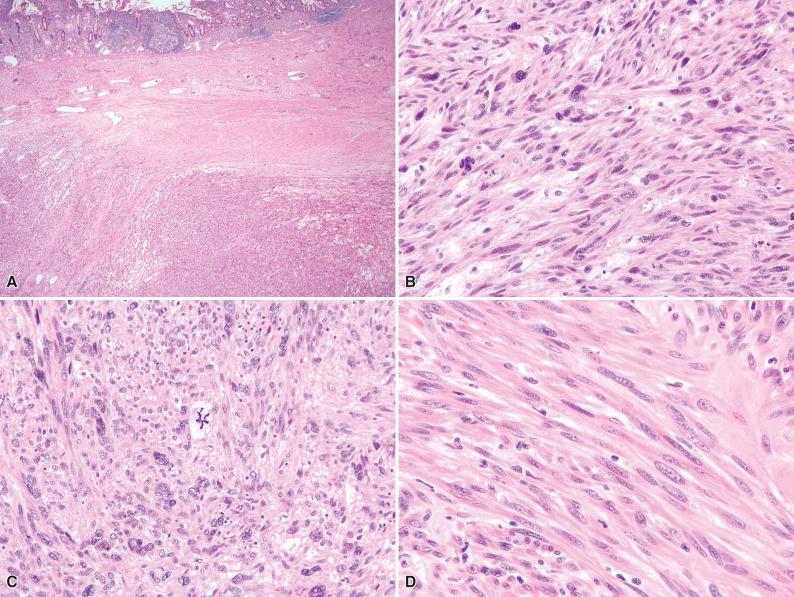
Leiomyosarcomas are usually diffusely and strongly positive for SMA. Expression of desmin and caldesmon is more variable and can be focal or diffuse. CD34 can be positive in smooth muscle tumors, including leiomyosarcomas. Broad-spectrum keratins are often at least focally positive. GI leiomyosarcomas are negative for S-100, KIT, and DOG1.
Leiomyosarcomas are characterized by complex genetic changes and do not possess KIT or PDGFRA mutations.
The differential diagnosis primarily includes GIST, leiomyoma, and schwannoma. Bright cytoplasmic eosinophilia and prominent nuclear pleomorphism distinguish leiomyosarcomas from GISTs. Furthermore, in contrast to leiomyosarcomas, GISTs are rarely positive for desmin and almost always positive for KIT and DOG1. GI leiomyomas lack cytologic pleomorphism and mitotic activity. Generally, distinguishing between GI leiomyomas and leiomyosarcomas is straightforward, because leiomyosarcomas usually show striking mitotic activity and marked nuclear atypia. However, occasionally, GI leiomyosarcomas are well differentiated with only focal cytologic atypia and a low mitotic rate. GI schwannomas usually arise in the stomach, an especially rare primary site for leiomyosarcomas. Unlike leiomyosarcomas, schwannomas have a peripheral lymphoid cuff and lack significant pleomorphism. Schwannomas are negative for desmin, and they are diffusely and strongly positive for S-100.
Leiomyosarcomas exhibit locally aggressive behavior and a high rate of distant metastasis. Leiomyosarcomas have a tendency to metastasize to intraabdominal surfaces and the liver, and they less often spread to the lungs and bone. GI leiomyosarcomas can also spread to regional lymph nodes, but this is rare. Many GI leiomyosarcomas ultimately lead to patient death. Aggressive multimodal therapy is required.
Schwannoma is a rare neoplasm of the GI tract, accounting for approximately 3% of all GI mesenchymal tumors.
Schwannoma can occur anywhere in the GI tract but is most common in the stomach, followed by the colon and rectum. The esophagus and small intestine are rarely affected. There is an equal sex predilection. Schwannomas develop in patients over a wide age range (18–87 years), with a median between 53 and 68 years.
Presenting symptoms depend on location. Patients with gastric schwannomas present with dyspepsia, indigestion, abdominal pain, a mass, or GI bleeding; those with colorectal schwannomas present with rectal bleeding, obstruction, constipation, or abdominal pain; and those with esophageal schwannomas present with chest pain or dysphagia. Schwannomas are generally located within the muscularis propria or submucosa with bulging into the lumen. The overlying mucosa is prone to ulceration. Interestingly, colorectal schwannomas have a tendency to appear as ulcerated polypoid lesions.
Grossly, most GI schwannomas are circumscribed, mural tumors ( Fig. 16.24A ). They range in size from 0.5 to 12 cm, with a median of 3–5 cm. On cut section, they are homogenous, firm or rubbery, and usually yellow. Hemorrhage, cystic change, or necrosis is not typically seen.
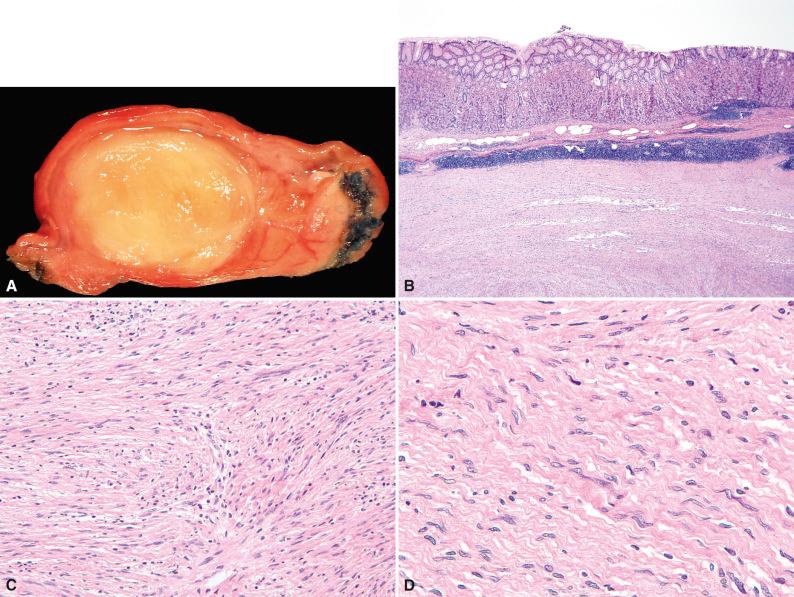
GI schwannomas differ histologically from conventional schwannomas of peripheral nerves. They are circumscribed but unencapsulated and usually surrounded by a dense lymphoplasmacytic cuff, often with germinal centers (see Fig. 16.24B ). They have overall pushing borders, but it is not unusual to see tumor cells infiltrate among the muscle bundles at the periphery. The vast majority of GI schwannomas are moderately cellular lesions composed of spindle cells with a variably prominent collagenous stroma (see Fig. 16.24C ). The lesional cells are admixed with lymphocytes and arranged in short bundles. In contrast to conventional schwannomas, Verocay bodies, nuclear palisading, perivascular hyalinization, or foamy histiocytes are not typically evident. The spindle cells contain elongated nuclei with tapering ends and a single inconspicuous nucleolus (see Fig. 16.24D ). There is often scattered mild nuclear atypia with hyperchromasia. Mitotic figures are usually absent or rare. Atypical mitotic figures are not identified.
Rarely, GI schwannoma can have epithelioid cytomorphology, similar to epithelioid schwannoma of the superficial soft tissues (see Chapter 15 ). The epithelioid cells are usually arranged in sheets or cords and sometimes in a pseudoglandular pattern. In a series of colorectal schwannomas, all four epithelioid examples were located in the descending or sigmoid colon, three of which were submucosal.
A rare variant of schwannoma referred to as microcystic/reticular schwannoma appears to have a predilection for the GI tract. In the largest reported series, 5 of the 10 tumors arose in the GI tract, 4 in the submucosa. These lesions had the typical clinical features of GI schwannoma but distinctive histologic features. All were circumscribed and unencapsulated, but none were surrounded by a lymphoid cuff. As their name implies, the lesional cells are arranged in a striking microcystic and reticular growth pattern composed of anastomosing spindle cells set in a myxoid, fibrillary, or collagenous stroma ( Fig. 16.25 ). Of note, the microcystic pattern may display a pseudoglandular appearance suggestive of mucinous adenocarcinoma. A case of signet-ring–cell schwannoma of the stomach has also been described; the appearance is similar to those tumors described as microcystic/reticular schwannoma.
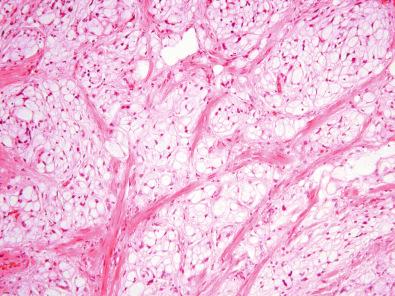
GI schwannomas are diffusely and strongly positive for S-100 ( Fig. 16.26 ) and glial fibrillary acidic protein (GFAP), but they are negative for KIT, desmin, and SMA. CD34 may be focally positive. Unlike conventional schwannomas, an epithelial membrane antigen (EMA)–positive perineurial capsule is absent.

GI schwannomas are sporadic tumors that are not associated with either NF1 or NF2. In contrast to conventional schwannoma, loss of heterozygosity at 22q12, the region of NF2 , is unusual. Loss of heterozygosity at 17q11.2, the region of the NF1 gene that encodes neurofibromin, is more common, being present in 50% of cases, which is similar to neurofibromas.
The main differential diagnosis of the most common spindle cell variant of schwannoma includes GIST, leiomyoma, inflammatory myofibroblastic tumor (IMT), and metastatic melanoma. Immunohistochemistry is helpful in distinguishing among different lesions in the differential diagnosis (see Table 16.1 ). GIST usually has a more hypercellular, syncytial appearance with minimal stroma and remarkably uniform cytology, and it lacks the distinctive peripheral lymphoid cuff of GI schwannoma. In contrast to schwannoma, GIST is positive for KIT and DOG1, and it is negative for S-100 in most cases. Leiomyoma has a uniformly fascicular architecture and bright cytoplasmic eosinophilia, and is negative for S-100 and diffusely and strongly positive for SMA, desmin, and caldesmon. IMT is composed of loose fascicles of plump spindle cells admixed with predominantly chronic inflammatory cells. IMT shows variable expression of SMA and desmin, and 50% for anaplastic lymphoma kinase (ALK), but it is consistently negative for S-100. Finally, metastatic melanoma also typically has extensive S-100 immunoreactivity. However, in contrast to schwannoma, these lesions may be positive for other melanocytic markers, including HMB-45 and melan A, and they usually have marked mitotic activity and striking nuclear atypia with prominent nucleoli.
GI schwannomas are invariably benign. Conservative excision is adequate therapy.
Most common in stomach (mural mass), followed by colon and rectum (polypoid mass)
Well circumscribed but unencapsulated
Surrounded by dense lymphoplasmacytic cuff
Unlike conventional schwannoma, usually no Verocay bodies, Antoni A and B zonation, or perivascular hyalinization
S-100 diffusely positive, KIT and DOG1 negative
Clear cell sarcoma (CCS) is a rare translocation-associated soft tissue neoplasm that generally involves the tendons and aponeuroses of the distal extremities. However, a CCS-like tumor has also been described in the GI tract. GI CCS-like tumors, which have also been referred to as osteoclast-rich tumors of the GI tract with features resembling CCS of soft parts and more recently as malignant gastrointestinal neuroectodermal tumor (GNET), have distinctive histologic and immunophenotypic features, leading to the conclusion that such tumors are not in fact simply GI tract examples of conventional CCS, but instead represent a unique tumor type with similar cytogenetic findings. Conventional CCS is discussed in Chapter 3 .
Become a Clinical Tree membership for Full access and enjoy Unlimited articles
If you are a member. Log in here